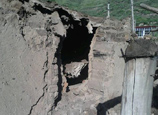
LANZHOU, July 22 (Xinhua) -- Under the scorching sun Wang Jihu and dozens of local villagers are cleaning dust and earth heaped on a section of the Great Wall in northwest China's Gansu Province, helping protect the ancient culture relic.
More than 50 villagers, including Wang, are building a flood prevention channel beside the wall.
Stretching 88 kilometers, the section of the wall that Wang is working on was built during the Ming Dynasty (1368A.D. - 1644A.D.). It is in Ximen Village, Shandan County. In total, more than 400 kilometers of the Great Wall can be found in Gansu.
Wang, 50, said he and his friends used to climb the wall during their childhood.
"We didn't recognize the significance of the Great Wall in the past, but just played there for fun. Things have changed, people who live around here now know the construction is a culture relic, and not allowed to be damaged," he said.
Gansu launched the flood prevention project in 2011 with investment of 30 million yuan (4.9 million U.S. dollars). Two phases of the project have been completed. The third phase involves constructing a 658-meter-long support structure either side of the wall and a 1,340-meter-long flood discharge channel.
"When this phase is completed, the Great Wall won't fear for floods anymore," said Song Chang, director of the Culture Relics Bureau of Shandan County.
Each villager taking part in the project is being paid about 100 yuan (16 U.S. dollars) per day, and they help out when not carrying out duties on their farms.
"It's a good way to increase villagers' income and also protect the Great Wall," Song added.
According to research released by the State Administration of Cultural Heritage, Gansu Province has the longest length of the Great Wall built in the Ming Dynasty. It has the second longest length of wall built in Qin (221B.C.--206 B.C.) and Han (202B.C.--220A.D.) dynasties.
Besides Gansu, walls, trenches and forts of the Great Wall have been discovered in Beijing, Tianjin, Hebei, Shanxi, Inner Mongolia, Shaanxi and Ningxia.
Unlike eastern parts of the Great Wall in Beijing and Hebei, which were mostly constructed with stones and bricks, sections in Gansu were built with earth. After centuries of erosion from fierce winds and sandstorms they have become extremely fragile.
More than ten consolidation and flood prevention projects have been implemented across Gansu Province in recent years, including at Shandan, Yumen and Dunhuang, said Xiao Xuezhi, vice director of the provincial culture heritage bureau.
The central government has spent more than 500 million yuan to finance the protection of the wall during the 11th Five-Year Plan (2006-2010).
Construction of the Great Wall, listed as a world cultural heritage site by UNESCO in 1987, began during the reign of China's first emperor, Qin Shihuang (259-210 B.C.), to keep out foreign invaders.
















 Solar halo observed in Beijing and Hebei, N China
Solar halo observed in Beijing and Hebei, N China


![]()
